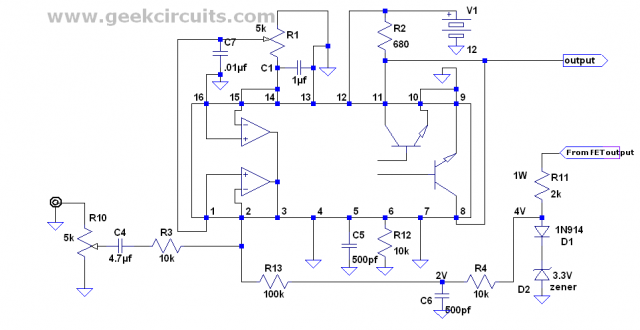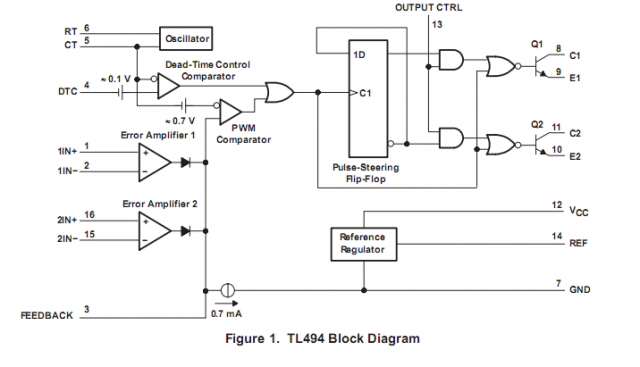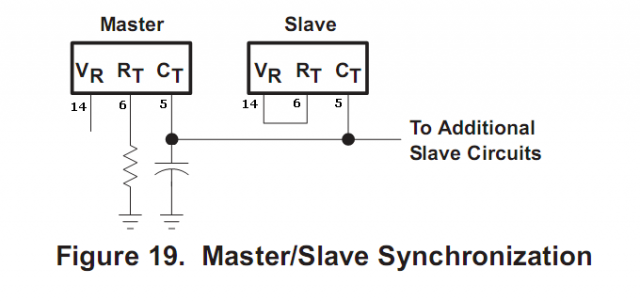Class D amp using TL494 DC to DC converter chip
- July 5th, 2010
It’s almost 5 years now since I published a topic regarding how to use TL494 as class d amp in a popular DIY audio forum. I think it’s quite good to include this article here also. By the way, before I publish that topic I thoroughly googled the said subject to see if there are some geek guys who have already done such a playful exploit of this chip but I simply got zero hit. This could mean that I am an early bird on this regard? Or maybe I am the only one who have a bizarre taste in choosing the right chip for such an application.
I tried to check that thread three years ago and noted that the counter say 15K views as I can remember, but when I checked it out recently, it increased to more than 24K views even the thread was buried and not being resurrected. This could mean that some are still peeping on that thread and it made me to think that I am not lone odd guy after all.
The circuit shown below is an improvised version from the original. The circuit use a NFB held at pin 3 of TL494 then feed back to pin 2 via resistor Rfb as required. The error amp output at pin 3 of the tl494 requires about 2 volts to bring the output pin 11 and 8 to 50% duty cycle. This will need a bias voltage of the same magnitude on its non-inverting i/p pin 1 as provided by voltage divider pot. The inverting input pin 2 having same level of 2 volts via Rfb completes the balance of those 3 nodes just like biasing a conventional opamp. Take note that these three pins are linear nodes and that connecting pin 3 to pin 2 in series with Rfb is a normal thing but what if we connect Rfb to the switching output of power FETs?
Figure a.
Schematic of a typical opamp biasing scheme. Pot R1 is used as DC offset null adjust and also 50% duty cycles adjust. You can connect a headphone in series with a coupling capacitor from the output to check if everything is fine.
The basic circuit above has a voltage gain of 10 based on conventional opamp gain equation of Av= R3/R4. This will require an input sensitivity of +/- 150mv to give an output of +/- 1.5 volt on pin 3 centered at 2 volts. The output at pin 11 and 8 will then modulate to approximately 5 to 95% centered at 50% on quiescent state (no audio).
The circuit showed below implements a FB also known as “pre filter negative feedback” (NFB) and obviously far better to reduce distortion and to improve frequency response. Since this output node is a switching mode with a voltage higher than 12 volts then there must be a constant amplitude regulator before we feed the NFB to pin 2. TL494 requires single-ended supply; this makes the audio input always referenced to ground. It’s a good option to use strings of diodes to act as “amplitude chopper” in such a way of accepting only “constant amplitude PWM” signal but not amplitude modulated signal. This is an attractive option because this technique will accept only the PWM signal from the power FETs and does not require filtering before feeding back the signal to the i/p of the opamp. Another unique feature of this FB schemes is that this will make the circuit inherently immune to power supply variations without affecting the NFB voltage. This means if a fellow is using either single ended or split bus supply of 30 volts, and he decides to use 50 volts or more, as long as the drivers and tl494 supply is regulated to 12 V, and the R11 is matched with a correct wattage, then it will not affect the NFB. But if the bus supply is increased or decreased, the NFB will aggravate the output of the amplifier if it were done without those diode strings. Substituting a simple voltage divider in a form of two resistors is possible but the required voltage for FB will change if the power supply varies so diode strings is far better. For 2 volts required for feedback, the diodes strings should have 4 volts (.62V + 3.3V approx.) square wave at 50% duty cycle on idle as seen from scope. This will yield an average of 2 volts DC from your DMM. Note! Please pay attention to the “phase inversion within the loop”. This means starting from input pin 2 via Rin up to the nodes of power FETs, there should be phase inversion. Some newbie may lose their attention to this inversion when the signal is being split into two as required by FET driver. Watch closely dude.
Figure b.
There are two important things to focus your attention regarding the circuit above. These are; implementation of dead time, and make sure phase inversion is present within the loop. Disregarding these 2 things may create trouble for the newbie to achieve correct operation. Dead time network D6, D7, R6, R7 along C8 and C9 are “optional components” just in case power FETs input dead time circuit is not enough. If high idling current is present then cross conduction is at work so you know what I mean. Second thing is the phase inversion within the loop must be present. Neglecting proper pull-up and pull-down of the input pins of exclusive OR gates will jeopardize the beauty of negative feedback. EXor gate output with input “pull-down” must be on the Hin pin 10 of IR2010 and the other gate output with input “pull-up” must be on the Lin pin 12. If those gate input pins were carelessly swapped differently from the drawing, then the entire loop will be converted into positive FB and will ruin the entire sound department. Please try to peep on your EXOR truth table to see what I mean.
Figure c.
Another filtered feedback variation can be seen above. This circuit utilized RC filter with -3db roll-off at 32kHz. If you want to listen to the sound of the circuit in fig. c, you can connect directly R11 to output pin 11, 8 because phase inversion is also present within that loop (from pin 2 to pin 11, 8). Sorry for this mistake, I noticed that my 32 ohm headphone effectively “overload” the 680 ohm at pin 11 (with capacitor) giving only 0.93 volts output as measured by my DMM. I got a distorted sound due to that and this loading also create wrong bias voltage to pin 2 as well. So, listening to this output with NFB and headphone together is not advisable.
Take note that removing RC filter R4 and C6 and connecting R11 directly to output pin 11,8 will produce good sound quality as well (yes, this is true if headphone is not connected there) possibly if additional buffer is available. Take note that small amount of DC offset is still present from the output and this is a function of parameter spread variations such as diodes voltage drop per degree C, supply voltage changes and etc. Simply adjust the pot at pin 14 to reduce the offset to the lowest as possible. I always favor a pot to null the DC offset or adjusting to required 50% duty cycle.
Designing a class D from scratch is a tough proposition especially for a beginner. This might put Tl494 in the prime list of a newbie’s baby step towards such first attempt. The availability and low cost nature of this chip coupled with high degree of repeatability, simplicity and stable in operation will surely improve the skill of a beginner. If he is creative or little bit ambitious enough; with guts so to speak, he will be surprised to see how practical tl494 to be use as a class D audio source. The very first Tl494 that I experimented was just extracted from a junk ATX power supply but when I put it on the breadboard with some caps and resistors the sound is surprisingly good!
Case in point: Tl494 contains three independent i/p pins that can be tailored to suite your listening needs. In my prototype an active band pass filter is tuned to 20 Hz (I love 20 Hz bass), another one as full audio band and then pin 4 take care of the treble at 7kHz, (I like rich in treble also). This practical approach simply eliminates my needs to build additional active crossover network. It’s totally complete inside the chip.
Figure d.
Suggested circuit employing tuned band pass active filter using the lower opamp as “mega bass enhancer” that peaks at 20Hz with +/-7Hz bandwidth. Then upper opamp is a simple full audio band, while pin 4 takes care of the treble with -3db roll-off at 7 KHz. Java script calculator for this active filter can be found here.
Did you notice the additional pot R9 from the circuit above? This is another adjustment for removing the offset voltage from the output because pin 4 requires 1.65V bias voltage as compared to pin 2 that needs 2V.
Let’s explore the innards of Tl494. Data sheet says; if the voltage at dead time pin 4 is varied from 0 to 3.3 volts, the output duty cycle will change from 5% to 100% (that’s non-inverting relative to output pin). Also, if the voltage is varied from .5 to 3.5 volts on pin 3, the duty cycle will vary from 97% to 0% (that’s inverting relative to output pin). But take note that the input signal is feed thru Rin of pin 2 which makes the loop also become “non-inverting” relative to output transistor. By the way, this pin 3 voltage should be centered at an average of 2 volts (.5+3.5/2) and also to pin 4 (0+3.3/2= 1.65V) to get 50% duty cycle from the output. Also take note that the author of the PDF did not mention if the output transistors are configured as emitter follower or just common emitter. These statements on PDF may confuse some folks (mind you, me too 6 years ago) but I just simply think that the author’s assumption referred it as emitter follower which is just fitted to the statement above. I also verified that on breadboard long time ago and it’s correct. But I preferred that the output transistors must be “common emitter” due to its lower saturation voltage than emitter follower. In this case, phase inversion will appear to pin 11, 8 output. Still confuse? Take a look at the schematic below for better enlightenment.
Synching of tl494 for multiple channel application.
Synchronizing multiple channels using tl494 is easy without any problem regarding audible bit frequency to occur compared to self oscillating class D approach.
Here is another suggested circuit employing the popular “bass and treble” tone control being used from linear circuits that most of you are familiar with.
Figure e.
The circuit above requires +/- 1.5 volt of input to get the required +/- 1.5 volt output from pin 3. This is due to the nature of this tone control network. When the 2 pots are both on their midpoint position then the voltage gain is 1 on pin 3.
Before you try any of the circuit shown above, try it first on the breadboard so that you can tweak the bass, the mids and high frequency by altering the R or C to your desired audio band. Or you can simply use only one opamp with one fb resistor to be simple one.







buenas,he tengo algo de experiencia con tl494 con inversores de voltaje,reguladores,voy a probar hacer este circuito luego comento,saludos.
ResponderEliminar